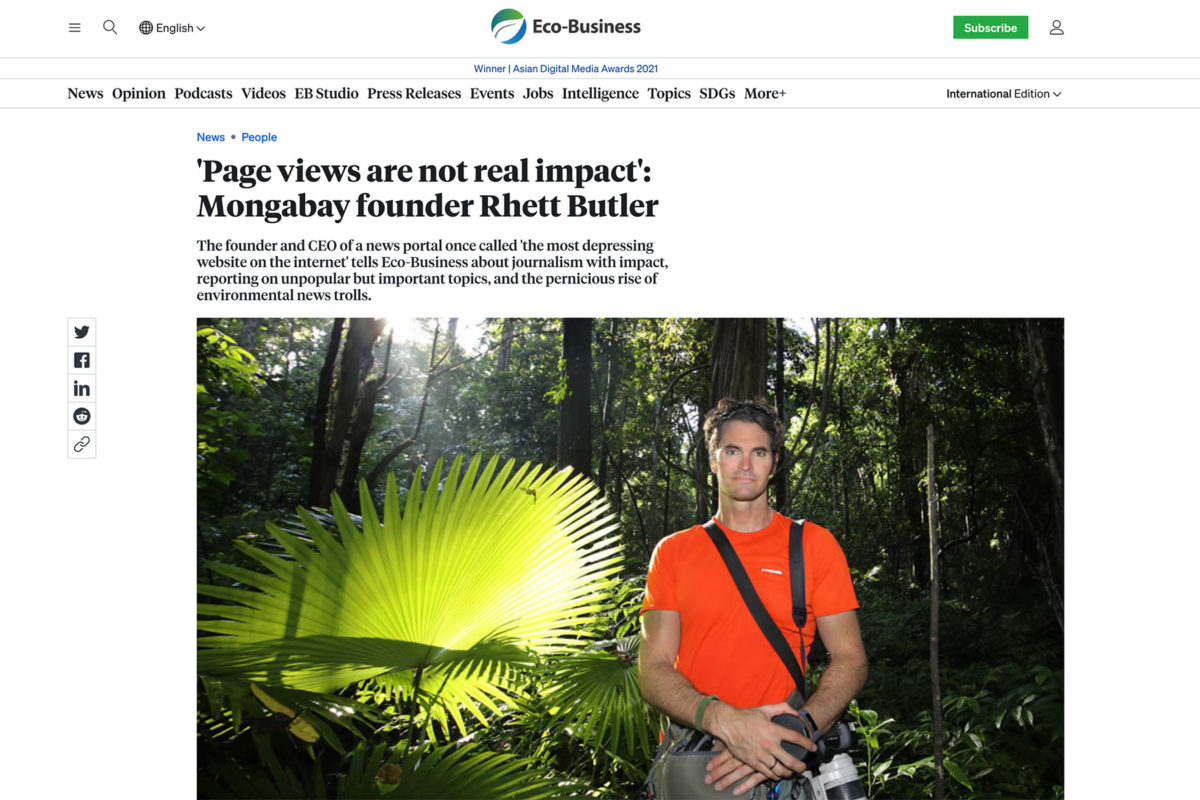In September I met with Robin Hicks of Eco-Business to talk about Mongabay, non-profit media, and trends in environmental journalism.
The resulting interview was published at ‘Page views are not real impact’: Mongabay founder Rhett Butler.
A few excerpts from the interview:
The challenge for newsrooms in finding the balance between gloomy environmental news and solutions has been debated recently. How does Mongabay navigate this problem?
In the past, Mongabay has been called the most depressing website on the internet! One way to navigate that problem is to do more solutions journalism. [Mongabay’s most-read Hindi-language story in 2021 was a piece on how rainwater harvesting is helping India to endure water insecurity]. But solutions journalism requires due diligence on the effectiveness of a solution. There’s a risk it is used to greenwash a solution.
Another problem is that most journalists don’t tend to get excited writing about solutions – that’s just the way they’re built. Journalists tend to focus on problems. Even if a solution was 90 per cent effective, the average journalist would probably focus on the 10 per cent that isn’t. So we frame solutions stories around how an environmental problem is being tackled.
People do need positive stories. Climate anxiety is a big issue. Meanwhile, news consumption globally has collapsed; 42 per cent of Americans actively avoid the news [according to a June study by Reuters Institute, which found even stronger news avoidance in Brazil and the United Kingdom].
What’s your approach to reporting on topics that can struggle to find an audience, for example stories about the rights of Indigenous peoples?
There are a few angles that have worked on Indigenous peoples’ rights. One is David versus Goliath. Another is uplifting, inspiring stories. But stories about communities wiped out in floods because of upstream deforestation – that’s pretty depressing and might not find a big audience.
But even if it doesn’t find a big audience, it is still an important topic to report on. These stories give a voice to under-represented communities. If your metric for success is just eyeballs you’re not going to achieve that. We don’t measure success based on traffic. We base it on impact. It also means we can give away our content for free because we’re not worried about losing advertisers.

Jambi, Sumatra, Indonesia. The photograph was taken via drone in a rainbow during Butler’s recent trip to Jambi. Image: Rhett Butler
How do you measure impact?
We don’t take full credit for policy changes or environmental wins, but we can say that we played some part in that outcome. On the quantitative side, it’s easy to show impact with readership, content syndication rates [Mongabay is published on a Creative Commons basis, so other media outlets can republish their content] and so on.
Qualitatively, Mongabay shows impact by going back to the journalist who did the reporting on, say, slavery in the Brazilian coffee industry, and asking them for an update. What has happened since the story was published? This is also beneficial to the journalist, as it gives them the chance to reconnect with their sources, which could lead to other stories.
No one remembers a story because it got 7 million page views. They remember it because, for example, a community fought back for its rights to a fishery, and now the community’s fishing yield has increased.

